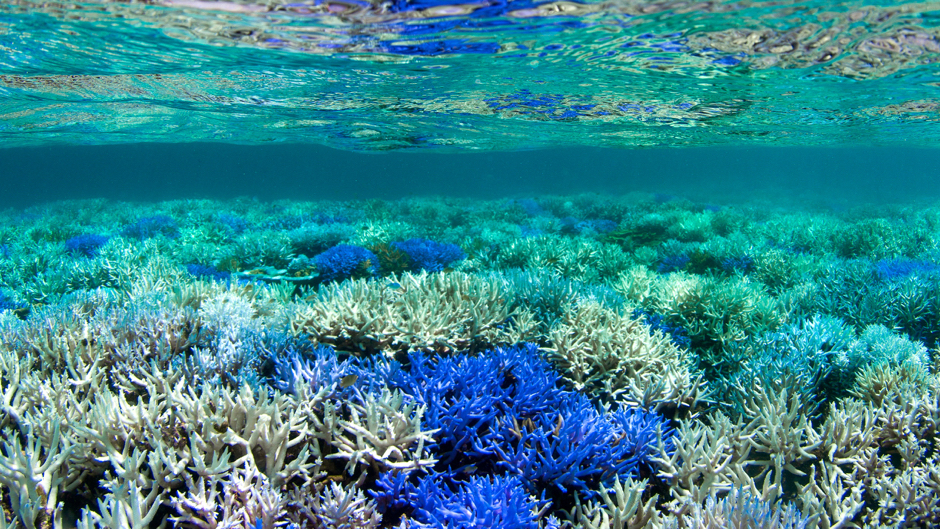Scientists at the University of Miami (UM) Rosenstiel School of Marine and Atmospheric Science are adding their voices and social media presence to amplify the Glowing, Glowing, Gone campaign, designed to raise awareness and inspire action on global coral bleaching. The campaign partners include The Ocean Agency, UN Environment Programme, Adobe, Pantone and the International Coral Reef Initiative.
To raise awareness about the threats to coral reefs worldwide, four research labs will “bleach” their logos during the month of August and use their Facebook, Instagram and Twitter accounts to discuss the latest science being employed to understand and better protect these critical ecosystems and services they provide. August is typically the most at-risk time of the year for coral bleaching in Florida.
Since 2005, scientists at the UM Rosenstiel School have helped continuously observe and monitor the summer coral bleaching activity along the 130-mile Florida Reef Tract, the largest living barrier reef in the continental United States that runs from the Florida Keys to Port St. Lucie. Warming ocean temperatures over the last two decades have contributed to increased coral bleaching events and the dramatic decline of coral populations around the world. This has prompted UM researchers to lend their support to increase awareness of coral bleaching and the threat it poses to coral reefs.
“Coral bleaching caused by a changing climate is an existential threat to the survival of reefs as we know them in many parts of the world,” said Andrew Baker, associate professor of Marine Biology and Ecology at the UM Rosenstiel School. “Good science and management can increase resilience of reefs and buy us a few years of extra time, but without immediate action on carbon and climate, these efforts may ultimately be in vain. This campaign is a great way to highlight the plight of corals before it is too late.”
Rosenstiel professor and coral researcher Peter Glynn, was the first scientist to link mass coral bleaching to unusually warm ocean temperatures during his seminal early studies of the 1982-83 El Niño event in the Eastern Tropical Pacific. Today, coral research conducted at the UM Rosenstiel School includes the Coral Reef Futures Lab, which studies coral bleaching and investigates ways to make corals more resilient to warming temperatures. The Benthic Ecology and Coral Restoration Lab, which includes the citizen science Rescue-a-Reef program, concentrates its work on coastal habitats of South Florida to understand the dynamics of these habitats and how best to protect and recover their populations through active restoration. The Cnidarian Immunity Laboratory, performs integrative biology to study the immunity, resilience and stress response in corals. The Ocean Acidification Coral Laboratory focuses on how corals respond to the combined stress of greenhouse warming and ocean acidification. The del Campo Lab studies the coral microbiome ecology and evolution, with a particular focus on coral disease, and how it is affected by climate change.
“Our Coral Restoration Lab is unique in that it acts as a vehicle for coral reef conservation and restoration. We are able to use the cutting-edge research of collaborating UM labs to drive best-practices and restore resilient reefs in the face of our climate crisis,” said Dalton Hesley, a senior research associate at UM’s Rosenstiel School and program manager of Rescue a Reef.
In addition, the UM Shark Research and Conservation Program will participate in the effort alongside their coral science colleagues to raise awareness about the many shark and other species that rely on coral reefs for their survival.
“A well-functioning reef includes the many animals that live among the corals, with healthy corals inextricably linked to healthy populations of fishes and vice versa,” said Neil Hammerschlag, a research associate professor at UM’s Rosenstiel School and director of UM’s Shark Research and Conservation Program. “For example, many reef sharks rely on coral reefs for both habitat and a reliable source of prey. In turn, corals rely on sharks for a source of nutrients they excrete on the reef.”
According to the National Oceanic and Atmospheric Administration (NOAA), coral reefs in southeast Florida have an asset value of $8.5 billion, generate $4.4 billion in local sales, $2 billion in local income and 70,400 full and part-time jobs. Coral reefs provide $375 billon per year for the global economy and support a quarter of all marine life.
Watch video: https://www.youtube.com/watch?v=O3U3mx7KT-s

